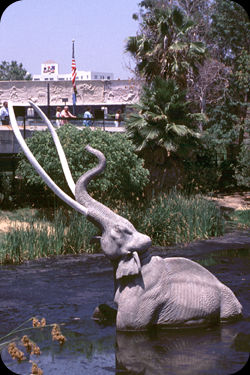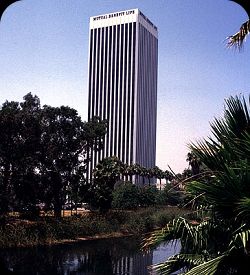We now
journey from New York to Los Angeles, California.

To the right we see a postcard view from the La Brea tar pits, on Wilshire Boulavard in the middle of LA. It is a most bizarre sight in the middle of a business strip to see a reserve where Los Angeles earlier inhabitants once lived and died.
The first thing you notice when you arrive at La Brea (Brea is the Spanish word for tar), is the smell. It's rapidly warming up the morning we get there and the stench of tar cuts through the smell of gasoline strongly enough to make you aware that you're, geologically speaking, somewhere unusual.
The La Brea tar pits are a geological anomaly, formed some twenty thousand years ago during a recent ice age. Climatic conditions changed the consistency of the tar, causing animals of the time to become trapped within the sticky goo. Temperature changes, (the earth becoming cooler), thickened the tar, and soon after soil and vegetable matter grew over the top, leaving the skeletons of the hapless animals perfectly preserved. But as we shall shortly see, these events were of mutual benefit, to the city and the museum.

The first thing I notice as I enter the George C. Page museum of La Brea discoveries, is the sign at the admission desk, in big handwritten letters that reads "There are no dinosaurs in this museum". It only takes a few minutes of discrete observation to see the disappointment on children's faces. Aren't all fossilised animal skeletons supposed to be of dinosaurs? The La Brea pits have revealed many magnificent specimens of now extinct cartoon animals such as woolly mammoths and sabre tooth tigers — hangovers from the Pleistocene Epoch, originating on the planes of East Africa. Dinosaurs are of a completely different age (becoming extinct some 60 million years ago), compared with the more recent La Brea finds dating from 15 to 30 thousand years ago.
Despite the containment of the collection inside a purpose designed building, museums cannot ignore the wider context from which they are viewed. The La Brea museum forces such comparisons, because it is both an active excavation site and the animals died on the very grounds on which the museum is built.
The
wider irony of the La Brea museum is clear when viewed from outside the
museum in the city of Los Angeles — here is a museum of animals that
drowned in tar (a form of crude oil), that is now bounded by a city that
is itself drowning in oil by-products. Whether the human
population will suffer the same fate as the La Brea discoveries remains
to be seen. At least the California State government is moving towards
zero emission vehicles, and current emission standards are amongst the
best in the world. But undoing the recklessness of the previous decades
will not happen overnight. You can taste the fumes with every breath you
draw in.
